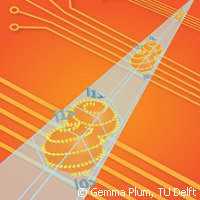EU-funded team in qubit control breakthrough
EU-funded scientists in the Netherlands have managed to rapidly control the building blocks of a quantum computer by using an electric field rather than a magnetic one. In addition, the team succeeded in embedding these building blocks, known as quantum bits or qubits, in a semiconductor nanowire. The study, published in the journal Nature, could lead to advances in the field of quantum computing and communication. EU support for the work came from the QUANTUMOPTOELECTR ('Quantum opto-electronics') project, a EUR 1.8 million Advanced Grant from the European Research Council (ERC) awarded to Professor Leo Kouwenhoven of the Kavli Institute of Nanoscience at Delft University of Technology (TU Delft). The project began in 2009 and runs until the end of 2013. ERC grants are financed through the Ideas Programme of the EU's Seventh Framework Programme (FP7). At the heart of the quantum computing concept is the qubit; this can be created by trapping an individual electron in a semiconductor material. Electrons can spin on their axis in two directions; in quantum computing, one direction represents the 0 state, and the other the 1 state, so that the qubit can effectively encode data just like a normal computer bit. Until now, scientists have controlled the spin of electrons using magnetic fields. However, it is extremely difficult to generate magnetic fields on a chip. As David Reilly of the University of Sydney, Australia, explains in an accompanying paper: 'Although proof-of-principle experiments have shown that nanometre-scale magnetic control is possible, the time it takes to rotate the orientation of the electron spin magnetically is long and does not allow for many rotations within a spin coherence time.' The spin coherence time refers to the period during which the information encoded in the quantum state of the spin is preserved. In a bid to get round this problem, Professor Kouwenhoven, along with colleagues from TU Delft and Eindhoven University of Technology, took a different approach, controlling spin through purely electric fields. To do this, they exploited an effect known as the spin-orbit interaction, which allows an electron's motion to influence its spin. In materials with a strong spin-orbit interaction, the electron's spin and orbital motion combine to create a hybrid state called a spin-orbit qubit; an electric field can control this. 'These spin-orbit qubits combine the best of both worlds,' commented Professor Kouwenhoven. 'They employ the advantages of both electronic control and information storage in the electron spin.' According to the team, in another important achievement they succeeded in embedding qubits in nanowires that are made of the semiconductor material indium arsenide (InAs) and are just nanometres in diameter and a matter of micrometres in length. Nanowires can be used in both electronic and optical devices. 'These nanowires are being increasingly used as convenient building blocks in nanoelectronics,' said Professor Kouwenhoven. 'Nanowires are an excellent platform for quantum information processing, among other applications. For more information, please visit: TU Delft: http://www.tudelft.nl Nature: http://www.nature.com/nature ERC: http://erc.europa.eu/ QUANTUMOPTOELECTR project page on CORDIS - click: here
Countries
Netherlands



